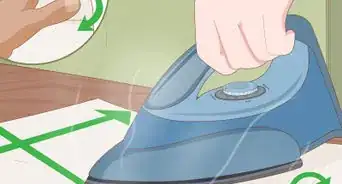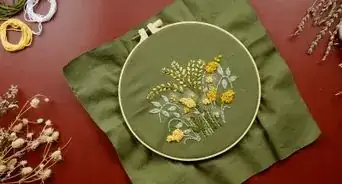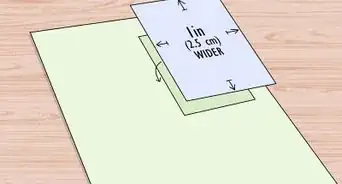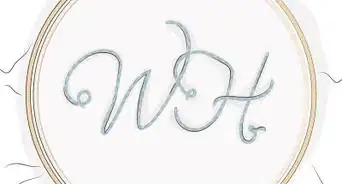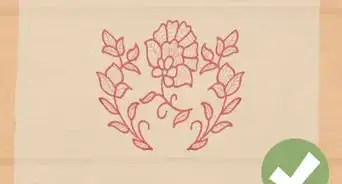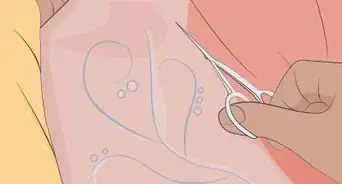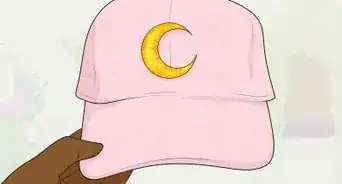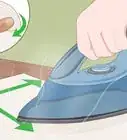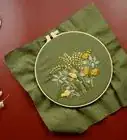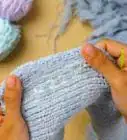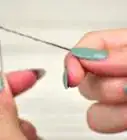This article was co-authored by Kpoene Kofi-Bruce and by wikiHow staff writer, Aly Rusciano. Kpoene Kofi-Bruce is a tailor, couture wedding gown designer, and the Creative Director of Mignonette Bridal and Ette the Wedding Tailor in Chicago, Illinois. With nearly two decades of experience as a wedding gown designer, small business owner, and vintage sewing enthusiast, Kpoene specializes in wedding gown design and the social history of wedding dresses. She received a BA in Creative Writing from Middlebury College and studied the business of fashion at the Fashion Institute of Technology. She is also a graduate of the Goldman Sachs 10KSB program and the Chicago Fashion Incubator and has written about wedding fashion for Jezebel, Catalyst, the Sun Times, and XO Jane.
There are 39 references cited in this article, which can be found at the bottom of the page.
This article has been viewed 26,284 times.
Embroidered flowers are super cute and trendy, but how can you make them? Believe it or not, embroidering flowers isn’t as hard as you may think! Flowers are the perfect designs for beginners and advanced hand embroiderers, as they help you learn and grow your needle skills. We’ve got all the different ways to embroider flowers, so keep reading to learn how you can stitch the flowers of your dreams.
Things You Should Know
- Use a straight stitch to make a simple flower petal.
- Use a woven wheel stitch or a french knot for roses.
- Use a lazy daisy stitch or a long and short stitch for curved petals like pansies.
- Use a chain stitch or a stem stitch for flower stems.
Steps
Straight Stitch for Simple Flower Petals
-
1Use a pencil or pen to sketch a dot with 5 lines branching out of it. Start with a single dot for the middle of your flower. Then, create 5 or more small lines coming out from the dot to represent the petals.
- Try using a heat erasable pen, so you can use an iron or hair dryer to make the ink disappear once you’ve finished your project.
-
2Bring the needle up at the top of a petal and down at the center dot. Following your design or pattern, pierce the needle through the fabric at the top of a petal. Next, guide the needle down through the center dot. This creates 1 straight stitch.[1]
- Use 2 to 6 strands of embroidery floss for this stitch.
- The more strands, the thicker the stitch will be.
Advertisement -
3Repeat the process of making straight stitches. Follow your pattern until all the pencil or pen marks are covered, and then end your stitch. This simple, beginner-friendly stitch creates adorable flowers that can be any size and color.
- Add more petals closer together to represent dandelions.
- Put a french knot in the center of the flower to tie the design together.
French Knot for Rose Buds and Flower Centers
-
1Bring the needle up through the fabric in the desired spot. Mark a dot on your fabric to help guide you. Wherever you mark your dot is right where your french knot will sit, so choose your location carefully.[2]
- For rose buds, place the stitch along a vine or throughout a bouquet design.
- For flower centers, place the stitch in the middle of a grouping of flower petals.
- Use 6 strands of floss for this stitch if you'd like a large french knot, or use 2 to 3 strands if you want a smaller one.
-
2Wrap the thread around the needle twice. Hold the needle away from you horizontally, so that the long side of the needle is facing you. Bring the thread up and over the needle twice with your free hand.[3]
-
3Point the needle down next to the hole you originally came up through. Hold onto the wrapped thread as you do this to keep it in place.[4]
-
4Bring the needle down through the other side. Hold the excess thread taut as you pull. Keep pulling until all the excess floss is threaded through the fabric to create a beautiful french knot.[5]
- French knots can be difficult, especially for beginners. Don't give up if your french knot doesn't look perfect at first!
Lazy Daisy Stitch for Oval Petals
-
1Outline a flower with oval petals on your fabric.[6] Start with a small circle to mark the center of your flower. Then, draw the full outline of your petals. Your flower can have 4, 5, or even 10 petals—it’s totally up to you!
- Make your petals about 1 in (2.5 cm) long.
-
2
-
3Poke the needle down next to your first puncture and hold onto the thread. Only pull the needle enough for you to get a grip on it. There’s no need to pull the thread all the way through, as the excess you’re holding will create the petal.[9]
- The length of the looped thread you’re holding onto should be long enough to reach the tip of the petal.
-
4Secure the top of the loop with your needle and thread. Keeping the loop of thread in place with one hand, use the other hand to poke the needle up through the fabric near the tip of your petal. Bring the needle back down over the loop of thread to secure it in place and create 1 petal.[10]
-
5Repeat this sequence until all you've outlined all your petals. This stitch can be used to create a handful of basic embroidery flowers, like daisies, lavender, sunflowers, and more! Experiment with thread colors to symbolize any flower with oval or raindrop petals.
Stem Stitch for Flower Stems
-
1Use a pencil to draw a line from the base of your flower.[11] Think about how flower stems are in real life. They can be straight, curved, or twisted, so the perfect stem can be any shape!
-
2
-
3Hold a needle’s length of thread with your thumb up and away from your work area. A stem stitch involves making a loop, and keeping some excess thread above your stitching space will make looping easier later.[14]
-
4Thread the needle back down through the fabric 1 stitch length away. Where you pull the needle through will indicate the length of your stitch. Keep your thumb holding onto that excess string—this will create the loop.[15]
-
5Bring the needle up halfway through the previous stitch. Guide the needle between the 2 stitches, let go of the excess thread, and pull everything towards your flower’s head.[16]
-
6Repeat this stitching process until you've filled in your outline. Keep going by making 1 stitch, then doubling back and coming back up halfway through your last stitch. A stem stitch gives a nice, solid line with no gaps, making it perfect for stems or vines of any flower type.[17]
Chain Stitch for Flower Stems and Branches
-
1Sketch your stem or branch before stitching. Use a pencil or pen to map out where you want your stitching to be. Draw out a straight line or a crooked line.[18]
-
2Make a single stitch for an anchor. Bring the needle up and through the fabric at the end of your sketched line. Then, thread the needle back down next to the hole you just made. Keep the holes close enough that it’s a small stitch but far enough that they don’t touch.[19]
- Use 2 to 6 strands of floss for this stitch.
- There are multiple ways to do a chain stitch, but this is the easiest way for beginners.
-
3Bring the needle up in front of your previous stitch. Leave a gap between your previous stitch and the start of your new stitch.[20]
-
4Slide the needle underneath your first stitch. Bring the needle under the loop of the previous stitch and gently slide it through. Tug until all the thread is secured tautly under the first stitch.[21]
-
5Pull the needle down through the hole you previously came up from. This creates the first chain in your chain stitch.[22]
-
6Poke the needle up through the fabric again. Leave a gap about the same width at your first chain. This is the start of the second stitch.[23]
-
7
-
8Guide the needle back down through the second stitch’s starting hole. This secures the second stitch and creates another chain.[26]
-
9Keep stitching chains until you reach the end of your pattern. The rustic texture of a chain stitch mimics spindly branches or bumpy stems.
Woven Wheel Stitch for Roses and Poppies
-
1Draw a circle on your fabric with a pencil. Make your circle the size you want your flower to be. This will be your guide as you stitch.[27]
-
2Make a 5-point star inside your circle. The first stitches of a woven wheel stitch are rather simple. Bring the needle up through the fabric, starting at the circle's border. Then, bring the needle down at the center of the circle. Repeat this process until you have a 5-pointed star.[28]
- Use 5 to 6 strands of floss for this stitch.
-
3Weave the needle under and over your 5 stitches. Bring the needle up at the center of the star. Guide the needle over the first stitch and under the second, pulling the thread all the way through. Continue this alternating weaving pattern in a counterclockwise pattern until the circle's filled in and the star's not seen.[29]
-
4Finish the woven wheel stitch by threading the needle under. When you reach the end of your flower, stick the needle back into the fabric. Use the needle to fluff out the flower petals.[30]
- Try using a color-changing embroidery floss for this stitch, as it can create a beautiful ombre effect.
Satin Stitch for Leaves
-
1Outline the shape of your leaf. Before you start stitching, draw out your leaf design using a pencil. Create a line down the middle of the leaf. This will help guide you as you stitch.
- Keep your outline thin as a thicker line covers more fabric and holes between them, making it harder to decide where to place your needle.[31]
-
2Create long and straight horizontal stitches on the left side of the leaf. Satin stitches are basically long, straight stitches; all you have to do to make them is bring the needle up, through, and back down again. Bring the needle up at the top border of your outline and back down through the line in the middle.[32]
-
3Bring the needle up again next to where you made your first stitch. This will start the second stitch in your sequence.[35]
-
4Make long, straight stitches on the right side of the leaf. Move on to the right when the left side's finished. Start at the bottom edge (or the closest space where you finished your previous stitch). Work your way up the pattern until you’ve reached the top of the leaf.[36]
- Working on the left and right sections separately creates a natural fold in the design, replicating the middle vein dividing a leaf’s blades.
Long and Short Stitches for Pansies
-
1Draw an outline of your flower with a pencil or pen. Long and short stitches fill spaces, so it’s best to have an outline with borders to guide you, even if you’re a more advanced embroiderer.
- Pansies generally have 3 front petals and 2 back petals that are rounded and slightly heart-shaped.[37]
-
2Guide the needle up through the back of the fabric.[38] Start at an outer corner of a petal.
- Use 3 strands of floss for this stitch.
-
3Bring the needle down at an opposite corner to make your first long stitch.[39] Follow the natural flow of your flower petal’s design by matching the direction of where the petal is coming out from the flower’s center. With pansy petals, you’ll most likely be making vertical stitches.
- If you’re unsure which direction the petals flow, pretend the flower is a star. The petals are the star’s points, and they all branch off from a center circle. The direction of these rays is the angle your stitches should follow.
-
4Make a second stitch that’s about half as long as the first one. Pull the floss taught, and then bring it back down along the start of the first stitch. This creates a short stitch.[40]
-
5Keep repeating a long-short stitch pattern until the petal is full. The stitches don’t have to fill the entire pattern right away. Try filling in the top half of a pansy petal and then filling in the bottom.[41] This will help give your embroidered flowers a more natural and painted look.
- Try using light and dark-toned colors to fill your pansy petals. For example, lilac and eggplant-colored threads will mimic the natural color diversity in pansies.
- Color-changing embroidery floss adds depth and variety to embroidered flower petals without manually changing floss colors.
Expert Q&A
-
QuestionCan you hand embroider silk?
 Kpoene Kofi-BruceKpoene Kofi-Bruce is a tailor, couture wedding gown designer, and the Creative Director of Mignonette Bridal and Ette the Wedding Tailor in Chicago, Illinois. With nearly two decades of experience as a wedding gown designer, small business owner, and vintage sewing enthusiast, Kpoene specializes in wedding gown design and the social history of wedding dresses. She received a BA in Creative Writing from Middlebury College and studied the business of fashion at the Fashion Institute of Technology. She is also a graduate of the Goldman Sachs 10KSB program and the Chicago Fashion Incubator and has written about wedding fashion for Jezebel, Catalyst, the Sun Times, and XO Jane.
Kpoene Kofi-BruceKpoene Kofi-Bruce is a tailor, couture wedding gown designer, and the Creative Director of Mignonette Bridal and Ette the Wedding Tailor in Chicago, Illinois. With nearly two decades of experience as a wedding gown designer, small business owner, and vintage sewing enthusiast, Kpoene specializes in wedding gown design and the social history of wedding dresses. She received a BA in Creative Writing from Middlebury College and studied the business of fashion at the Fashion Institute of Technology. She is also a graduate of the Goldman Sachs 10KSB program and the Chicago Fashion Incubator and has written about wedding fashion for Jezebel, Catalyst, the Sun Times, and XO Jane.
Couture Bridal Designer Sure! Most fabrics can be embroidered. but make sure to trace your design first and to place your needle exactly on the tracing, as silk can "shatter" easily. If you're adding details to a wedding dress or something that has sentimental value, I recommend embroidering onto a patch and then attaching that, rather than embroidering directly onto the garment.
Sure! Most fabrics can be embroidered. but make sure to trace your design first and to place your needle exactly on the tracing, as silk can "shatter" easily. If you're adding details to a wedding dress or something that has sentimental value, I recommend embroidering onto a patch and then attaching that, rather than embroidering directly onto the garment.
Things You’ll Need
- Embroidery hoop
- Fabric
- Needle
- Embroidery floss
- Pencil or pen
- Heat erasable pen (optional)
References
- ↑ https://youtu.be/Rr7PKYC6uEY?t=5
- ↑ https://youtu.be/pjI5yo656U4?t=4
- ↑ https://youtu.be/pjI5yo656U4?t=13
- ↑ https://youtu.be/pjI5yo656U4?t=20
- ↑ https://youtu.be/pjI5yo656U4?t=41
- ↑ https://www.wanderingthreadsembroidery.com/lazy-daisy-embroidery-stitch-tutorial/
- ↑ https://www.wanderingthreadsembroidery.com/lazy-daisy-embroidery-stitch-tutorial/
- ↑ https://youtu.be/JGa4PoQB408?t=1042
- ↑ https://youtu.be/OWv6Ypzn9dg?t=322
- ↑ https://youtu.be/OWv6Ypzn9dg?t=326
- ↑ https://youtu.be/JGa4PoQB408?t=885
- ↑ https://youtu.be/JGa4PoQB408?t=891
- ↑ https://youtu.be/JGa4PoQB408?t=879
- ↑ https://youtu.be/JGa4PoQB408?t=898
- ↑ https://youtu.be/JGa4PoQB408?t=908
- ↑ https://youtu.be/JGa4PoQB408?t=918
- ↑ https://youtu.be/JGa4PoQB408?t=977
- ↑ https://youtu.be/JGa4PoQB408?t=714
- ↑ https://youtu.be/JGa4PoQB408?t=727
- ↑ https://youtu.be/JGa4PoQB408?t=742
- ↑ https://youtu.be/JGa4PoQB408?t=759
- ↑ https://youtu.be/JGa4PoQB408?t=776
- ↑ https://youtu.be/JGa4PoQB408?t=786
- ↑ https://youtu.be/JGa4PoQB408?t=794
- ↑ https://youtu.be/JGa4PoQB408?t=802
- ↑ https://youtu.be/JGa4PoQB408?t=814
- ↑ https://youtu.be/OWv6Ypzn9dg?t=474
- ↑ https://youtu.be/OWv6Ypzn9dg?t=474
- ↑ https://youtu.be/OWv6Ypzn9dg?t=503
- ↑ https://youtu.be/OWv6Ypzn9dg?t=545
- ↑ https://youtu.be/hRDo0w7l6EA?t=109
- ↑ https://youtu.be/7riGZzsP4go?t=1154
- ↑ https://youtu.be/hRDo0w7l6EA?t=86
- ↑ https://youtu.be/hRDo0w7l6EA?t=209
- ↑ https://youtu.be/7riGZzsP4go?t=1170
- ↑ https://youtu.be/7riGZzsP4go?t=1316
- ↑ https://youtu.be/vfoWYqnAt7E?t=86
- ↑ https://youtu.be/JGa4PoQB408?t=1710
- ↑ https://youtu.be/JGa4PoQB408?t=1717
- ↑ https://youtu.be/JGa4PoQB408?t=1732
- ↑ https://youtu.be/OWv6Ypzn9dg?t=266
